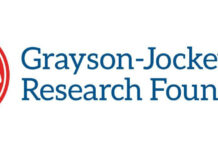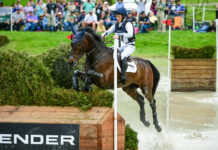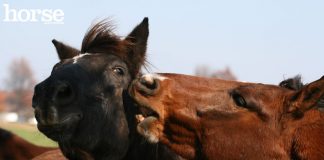
Your normally mild-mannered horse has begun to toss his head, refusing directions and acting impatient when you ask him to wait. While under tack, he slams on the brakes and rubs his nose on his legs, jump standards or anything within reach. You’ve also noticed that he snorts to clear his nose repeatedly while working—not just while you warm up, like he’s done in the past.
What It Is
Headshaking is an uncontrollable, persistent or intermittent shaking of the head, explains Dr. Stephen Reed, DVM, DACVIM of Rood and Riddle Equine Hospital in Lexington, Ky. Headshaking can be seasonal (spring and summer), with some reduction in the fall and winter, but headshaking can be seen any time of year. A stereotypical headshaker will repetitively jerk his head in either a vertical, horizontal or circular motion.
Who is Affected
Headshaking is a condition that has some similarities to trigeminal neuritis in humans, explains Dr. Reed, but it is not exactly the same. Based on information provided to the University of California at Davis, the breeds most commonly affected are Thoroughbreds (41 percent of the horses in the survey responses—Thoroughbreds are three times more likely to be affected than other breeds), Quarter Horses and Paints (24 percent), Warmbloods (16 percent) and other breeds (19 percent), including Morgans, Arabians, Paso Finos and Appaloosas.
Dr. Reed also comments that headshaking has been seen more in geldings than in stallions or mares.
There is no one area of the country that has more headshaking horses than others; it is a nationwide issue. Dr. Reed recently returned from a meeting Rome, Italy, in which it was stated that headshaking was considered to be one of the biggest problems facing sport horse riders in Italy and other parts of Europe.
Dr. Reed does not believe that headshaking syndrome has been on the rise, but that more people are aware of the problem and more owners are pursuing determining the cause so that treatment can be directed at the specific cause one it is recognized.
Diagnosis
There is no one “test” that can prove if your horse is a headshaker—the diagnosis centers on the recognition of clinical signs. Some horses may exhibit multiple signs (rubbing his nose repeatedly, snorting and violent jerking of the head), while others may exhibit only one of these signs.
You may be inclined to reprimand your horse for these actions, but it’s important to remember that these motions are strictly involuntary and that disciplining your horse may increase his anxiousness, pain and distress.
There are many causes of headshaking, says Dr. Reed, so it becomes a search to identify some organic disease that is causing the horse to have hypersensitivity or pain that manifests through the trigeminal nerve (the cranial nerve responsible for sensation in the face.) At one time, there was a widespread belief that headshaking was related to photic (sunlight) causes alone, but over time, many owners and veterinarians have noted that a headshaking episode can be precipitated by sound or touch, he notes.
Some of the factors that can set off a headshaking episode can include light, touch (such as from a particular brow band on a bridle), loud noises, dental disease, sinusitis, temperohyoid osteopathy (a progressive disease of the middle ear), allergic rhinitis, ethmoidal hematoma (a mass in the paranasal sinuses that is locally destructive) or ear ticks, just to name a few, Dr. Reed explains.
All of these are suspected causes, and the only way to determine if they truly are triggers for a headshaking episode in your horse is to stop the signs with a nerve block or administer treatment for a specific sign to determine if there is a change in behavior. If there is, you have identified one cause of your horse’s headshaking (there can be multiple triggers).
To determine what is causing your horse’s discomfort, your vet may perform a dental exam, endoscopy, radiographs, nerve block and/or a neurological exam. She may also have your horse wear special sunglasses or block the air moving up his nasal passageways to see if that helps decrease or eliminate the headshaking.
Prognosis
All is not lost if your horse is diagnosed as a headshaker. His treatment plan will be based on an accurate diagnosis, and some causes of headshaking are more easily treated than others. Dr. Reed reiterates that owners must understand that they will be managing the problem for some time. The prognosis for a diagnosed headshaker is guarded, and depends on just how afflicted the horse is. Not all horses present the same way or have the same degree of discomfort.
Additionally, It never hurts to try new products and theories, as well. You might find that you’re able to continue to ride your headshaking horse as long as he wears a nose net or a fly mask.
Management
Management of a headshaker is best done with medication, says Dr. Reed. One of the medications commonly used is cyproheptadine, an anticholinergic serotonin antagonist and histamine blocking agent. Some horses may be treated with carbamazapine, a sodium channel blocking anti-convulsant. Recently there has been work demonstrating use of electrical impulse therapy as beneficial for horses where sun masks and netting over the nose have failed to improve the clinical signs. Although surgical techniques to desensitize the region or to stop pressure on the trigeminal nerve have been used in people and suggested for use in horses these do not appear to have evidence of clinical efficacy in horses.
Liked this article? Here are others you’ll enjoy:
Video: Fix Head Tossing with John Lyons
Sarah Coleman has a soft spot for chestnuts with chrome, including her off-the-track Thoroughbred that she competes in the hunters. Based in Lexington, Ky., she is the Director of Education and Development for New Vocations Racehorse Adoption Program.







great info! I have a friend going through the same thing with her horse, and trying to figure out why he shakes his head so much.
I have a 15 yr. Old appendix who does this,not on a daily basis, but when he does it takes over and makes our riding difficult. I thought he was just being obstinate ,and have checked bits, bridles, girths, and used as light a touch as possible to no avail. Thank you for the information.
What about Cranio sacral therapy? It had great results with headshakers.
A friend of mine has a thoroughbred gelding that does this. Only when he shakes he gets faster and faster and doesn’t listen to cues, so it can be quite dangerous. She uses a hairnet that attaches to his bridle and goes over his nose. This is enough to keep him focused and seems to work pretty well!